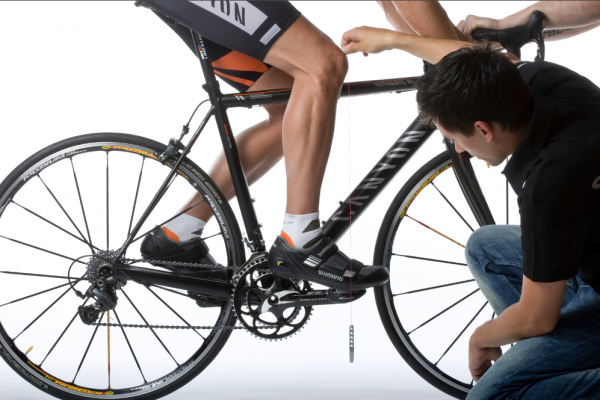Fore Aft Saddle position
 The fore aft saddle position corresponds to how close or how far the seat is in relation to the handlebars. This positioning is important because it affects your balance as well as your overall comfort level, power and efficiency.
The fore aft saddle position corresponds to how close or how far the seat is in relation to the handlebars. This positioning is important because it affects your balance as well as your overall comfort level, power and efficiency.
The Knee Over Pedal Spindle Method
The generally accepted way to find the proper saddle position is called knee over pedal spindle (KOPS). To find KOPS sit on the bike with the pedals at the 3 o’clock and 9 o’clock position. Hold a plumb bob at the front of your forward kneecap and see where it hits in relation to the pedal spindle. The line should intersect the pedal spindle/axel. If it falls in front, adjust the saddle rearward. If it falls behind, adjust the saddle forward.
Although the knee over pedal spindle method is quick and easy to do, it does not take into account your individual body type, flexibility or pedalling style.
The Balance Point Fore Aft Saddle Position Method
Grab a friend and warm up on an indoor trainer for 10 minutes, once you have sufficiently warmed up have your friend stand in front of the bicycle and wait. Get into the drops and start pedalling at approximately 80% of maximum effort (a pace you could maintain for an hour) and then swing your hands back behind your butt. You should be able to balance on that point WITHOUT falling forward (that is why your friend is there) or arching your back.
To find the ideal fore or aft saddle position it should be adjusted just forward enough so that your friend barely has to help your torso from falling (a bit forward of the centre of gravity). This is your ideal fore and aft saddle position assuming that your saddle height, saddle tilt and reach to the drops is approximately in the correct position. Ie. If your saddle height is too low or the saddle tilt is up, then it is easier to balance.
Signs That Your Fore Aft Saddle Position is Set Too Far Back
If your saddle is set too far back then you are going to have a lot of power on the flats and slight inclines because you will be able to produce a lot of power; however, once the road turns up (steep grade) then you will not have enough weight over the pedals and you will be forced to stand up to climb. Additionally, a saddle that is adjusted too far back will make it more difficult to maintain a high cadence. Knee pain in the back of the knee can also be caused by a saddle position located too far back.
Signs That Your Fore Aft Saddle Position is Set Too Far Forward
If your saddle is set too far forward then you may be using your upper body too much causing tension in the shoulders and arms as well as having sore hands. You will be able to have a quicker cadence but you will tend to sit back on the saddle up climbs. Additionally, you will be using your upper body muscles to support yourself, wasting valuable energy, and not allowing the torso be relaxed to be able to breathe deeply and properly. Knee pain in the front of the knee (under the knee cap) can be caused by a saddle that is set too far forward.
The Balance Point Method vs the KOPS Method
The whole point of finding the balance point is to allow your upper body to be relaxed and focused on breathing (feeding the engine) while the lower body is focused on propelling the bike forward. You want to optimize feeding the engine with as much fuel (oxygen) as you can so it can go as fast as possible.
If you use knee over pedal spindle method then differences in the lower and upper body are not taken into account. For example: if you are not flexible in the lower back then your centre of gravity is going to be more rearward; therefore, the saddle should come forward more than that of a flexible cyclist. As noted above having a saddle too far back or too far forward is not a benefit.
I would recommend using the balance point method to find your fore aft saddle position as it takes in to account individual differences in body types, flexibility and riding style.